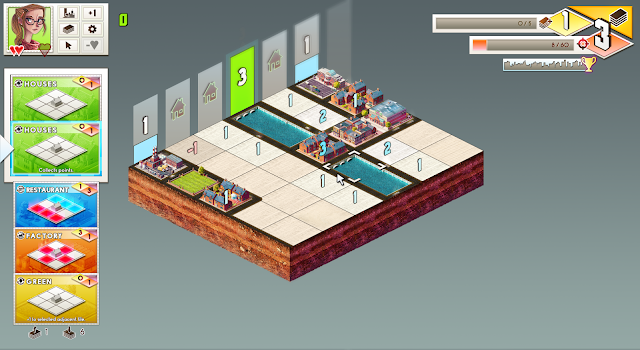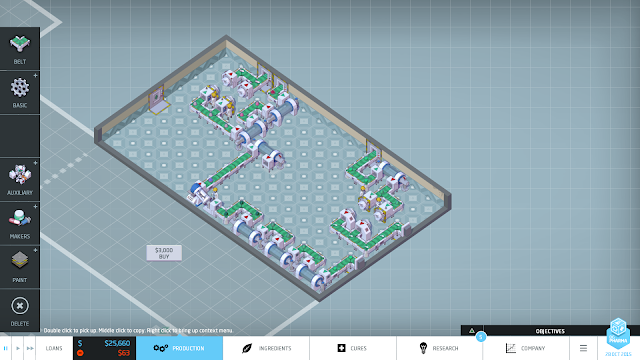What I like: The deck building campaign mode offered just enough moving parts and variety to keep me engaged. The goofy story bits were sometimes amusing.
Not So Much: The custom games are probably a bit too repetitive to hold my attention.
Other Stuff You May Like: Competitive mode can be played hotseat with or against another human, or any creature that can work a computer.
The Verdict: I had a fun time working through the campaign and a small handful of custom games. This isn't a game I'll play for 100+ hours but did enjoy my 3 dozen hours or so.
About my reviews
Official site: Concrete Jungle
Getting Started!
Concrete Jungle is a city builder themed deck building card placement game. What the heck does that even mean? Don't think SimCity, Anno or The Settlers. Buildings are placed on a board to collect points. No mining gold or production chains. There are 4 basic ways to play. Solo - the player is the only one placing buildings on the board. Competitive vs AI or another hotseat player - multiple players are competing for points on the same board. Classic - same as solo, but the deck building aspect is removed and the player is randomly fed cards.At first I'll cover solo mode. I'll cover the wrinkles added in competitive mode later on. Basically, the game goes like this. The board is arranged into columns. Buildings (cards) are placed onto the board for a variety of effects. Tiles can have a point value associated with it, either due to starting conditions or from the effect of played cards. Some cards can claim points, adding them to your score. Others have different effects - such as raise or lower the point value of tiles, moving the points from one tile and putting them on another, negating the value, and more. Most cards differentiate themselves by the pattern of tiles that they affect, but some of the special ones are a bit more interesting.
 |
| An early scenario in the campaign. |
Technology
Technology is one of the two resources to manage and is displayed in the yellow diamond. The house doesn't give the player any technology benefit since it's yellow diamond is 0, but the restaurant and factory do. Once enough technology is accumulated, you can purchase a new card or ability. |
| The player gets to chose 1 of 4 cards when they acquire enough technology, or... |
 |
| ... unlock a new ability. |
Many times an ability is simply acquiring a special card. After the ballet school is played on the board, that player can choose one of their top 3 cards to play instead of the top 2 - providing a bit more flexibility. It's amazing how much that can help sometimes. All abilities on the tree aren't unlocked right away. As new cards are added to the deck when the technology level is increased, higher tiers of abilities are unlocked. Technology upgrades are a balance of choosing useful cards in the shop and unlocking the abilities. There are 8 playable characters once you beat them in the campaign. They do play differently enough to add variety and have cards in their ability tree that are special to them.
The Price of Progress
As the city is developed, the available tiles fill up. The left column must be cleared before a new one appears along the right edge, providing more space for development. It's game over if there aren't any more free tiles to develop. The left column can only be cleared when enough points are claimed. This target value rises as the player accumulates costs from placing buildings. The player does get one free pass to force the left column to be cleared and can earn more as points are scored.Each card has a cost associated with it (displayed in the orange diamond). When the accumulated costs hits a threshold the point total needed to clear a column goes up. This makes the game more difficult to continue as progress is made.
The End of the Road
Solo games end when either enough columns are cleared, or if the player fails to clear the left column and has nowhere else to build. Custom games can be set to endless mode, where failure is the only end of the game. Basic leaderboards are available in either case for those motivated by chasing scores. The leaderboards are rather basic, showing only the top ten scores, which can be filtered by friends.Competitive Mode

Competitive (versus) mode offers up some new challenges. The board is divided up into an area where only the blue player can build, a neutral area in the middle for either player, and an area where only the red player can build. That doesn't mean you can't affect the other player though. A building can be placed on the edge of the other player's area to lower their score. More advanced buildings exist that affect an entire row or column too. Special one-time use cards can be unlocked to steal the points from the enemy's tile and plop them onto one of yours.
You can also mess with the other player in other ways. I've claimed the 2nd column with 4 points. If the other player can manipulate his pink tile to have a negative value and then claim that title, I'll get those negative points too since the column is mine. If the other player had positive points but less than 4, I'd acquire those additional points too. Battles for columns can be risky because it may lead to giving the other player more points if you fall short.
In competitive mode the left column clears when the point threshold is met or it is fully developed. There is no penalty for not reaching the point threshold like in solo mode.
The Campaign
The game also contains an 18 mission story-based campaign, which is a mixture of solo and competitive play. It starts off teaching the ropes and progresses to some challenging competitive play. The story is intentionally goofy and can be fairly amusing at times with its odd cast of characters. One big advantage of campaign mode is that the competitive play contains a variety of maps. It isn't always separated into areas of 2 columns for the red team, 2 for the blue and 2 neutral. There can also be tiles which already contain points, or buildings which take away development space. This variety elevated the game for me, where the custom games get repetitive.Technical Performance / Non Gameplay
I can't imagine the game taxing most machines. The AI does think a bit before taking its turn, but it is a matter of seconds, not half a minute. I haven't had any crashes.
My specs: Windows 7 64-bit. Intel Core i& 860 @ 2.80 GHz. 8 Gig RAM. NVidia GTX 970.
Some players may be turned off by having to unlock characters by playing the campaign, and needing to play to unlock some cards, but I like having the carrots dangled in front of me.
While I think competitive mode offers that most interesting decisions, and I enjoyed the competitive missions in the campaign, I don't think I'll revisit them in custom games. I'm kind of a score chaser by heart and there aren't any leaderboards for competitive mode. The AI did smartly place their buildings. I was glad the AI didn't blunder its way through the game.
My specs: Windows 7 64-bit. Intel Core i& 860 @ 2.80 GHz. 8 Gig RAM. NVidia GTX 970.
Conclusion
Concrete Jungle is city building in theme only, but that's OK. Overall, I've had a good time with it. Since it is a deck building game, there is luck involved but I feel the player has enough agency to have enough of an effect on the outcome. The campaign wasn't too challenging until the final 4 scenarios or so. Two were particularly tough. When I snatched victory away during the final moments it did feel rewarding.Some players may be turned off by having to unlock characters by playing the campaign, and needing to play to unlock some cards, but I like having the carrots dangled in front of me.
While I think competitive mode offers that most interesting decisions, and I enjoyed the competitive missions in the campaign, I don't think I'll revisit them in custom games. I'm kind of a score chaser by heart and there aren't any leaderboards for competitive mode. The AI did smartly place their buildings. I was glad the AI didn't blunder its way through the game.
Frankly, I may try a handful of endless mode solo games with the different characters, but I feel that I've seen what the game has to offer. I enjoyed my time with Concrete Jungle and have played for 30 hours or so. To me, that's plenty for a $13 game. While I don't think it is probably on many people's' "Must Play" lists, Concrete Jungle is a solid game. In fact I wasn't even planning on writing a review, but after wrapping up the campaign I liked it enough so I wanted to share my thoughts.













































